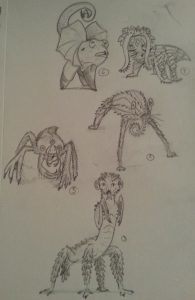Terrestrial Vertebrates
The Union of Sapient Species the the second largest known multi-timeline legal union, encompassing over a hundred sapient species from nearly as many parallel Earths. A few of those species are related to humans, their timelines having diverged within the last million years. Others are…more distant.
1)
Most basal among the craniates of the USS are thes, descended from cyclostomes most closely related to Human Earth’s lampreys and hagfish. Jawless, 211-115s process food with their forelimbs (also used to manipulate tools) and a forked, toothed radula. Three pairs of lungs in the upper ribcage draw in air and produce the harmonic triads that compose 211-115 languages. Their integument of hollow keratin cones insulate their bodies and (in the case of the ear-horns) focus sound. Current diplomatic relations between Human and 211-115 Earths are warm.
2)
The dondokodondons are ostracoderms, more closely related to jawed vertebrates than cyclostomes, but still jawless. Dondokodondons’ ancestors evolved calciferous bone, but grow it as an exoskeleton outside their skin. Their skull-like cephalons are supported by three limbs, homologous to the pectoral fins and tails of their swimming ancestors. They grasp tools and process food with tooth-covered radulae. Diplomatic relations with Human Earth are limited to trade in manufactured goods conducted in a single space station.
3)
Although they walk on four limbs, pwikpwuks are not tetrapods like humans, but chondrichthyes, related to sharks. Like dondokodondons, pwikpwuks’ cartilaginous internal skeletons are not strong enough to support their weight. Their external skeletons of dentine support their limbs and muscles. Denticles also cover the sensative manipulatory barbels, which allow pwikpwuks to capture food. Relations with Human Earth have been strained since a homeless man was unfortunately devoured by pwikpwuk tourists in San Francisco.
4)
That’s us
5)
Like tetrapods, tlaatlhhatls evolved from lobe-finned fishes, but conquered the land independently. Their four fins are each split four pairs of branching digits on which they walk and with which they capture and process food. The evolution of their third pituitary eye is mysterious. The human United Nations enjoys close relations with the tlaatlhatl planetary government, but efforts to promote tourism have proved largely fruitless. The blame likely falls on human arachnophobia.
6)
Vhngbas evolved from teleost fishes after an extinction far worse than the one that killed the dinosaurs of Human Earth. Their fused pelvic fins form a single pillar-like hoof, supplemented by the more flexible limbs derived from the pectoral fins. The dorsal and adipose finds curl around the earing/vocalization openings in their breathing chambers, amplifying booth hearing and speech, while a hand derived from the caudal fin manipulates tools. Sapient-rights violations by the largest vhngba social hegemony resulted in sanction and embargo from USS members, intensifying mutual hostility between Vhngba and Human Earths.
This one is inspired by @jayrockin, @deinocheirus, and @viergacht. Get well soon, @viergacht!
Done while listening to Dora and Friends (con todos mis amigos).





